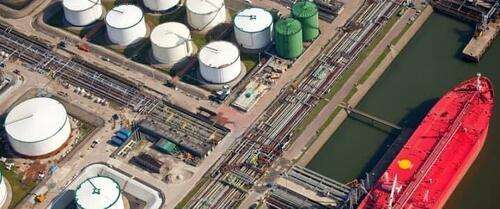Authored by Simon Watkins via OilPrice.com,
- Moscow signed 10 new cooperation agreements with Iran for the oil sector alone on 18 May.
- China waited for the dust to settle before it too signed new cooperation agreements with Iran on 23 May.
- China has significantly expanded its influence in the Middle East in order to secure sufficient hydrocarbon supplies to fuel its economic growth.
In May or so has seen a flurry of major cooperation agreements – including in energy, security, and logistics – between various permutations of Iran, Iraq, Russia, and China. Like a very dark version of the old U.S. soap opera parody ‘Soap’ this real-life version is equally convoluted, albeit a lot less funny. Its key elements constitute a significant part of the new global oil market order, which is analysed in depth in my new book on the subject, but the three most recent principal cooperation agreements will have immediate consequences for oil and gas flows around the world and their pricing.
The best place to start here is at the end point of what China wants in its grand scheme of things, as delineated in its multi-generational power-grab project, ‘One Belt, One Road’. What it wants is to turn the Middle East into a large oil and gas station by which it can fuel its economic growth to overtake the U.S. as the number one superpower by 2030. The three biggest oil and gas reserves in the region belong to Iran, Iraq, and Saudi Arabia, so it wants to control those to begin with. For Russia, which already has lots of oil and gas – over which China already has significant control – the objectives in the Middle East are more varied. One objective is to continue to exert influence in several countries that it regards as being key to maintaining some of its hold over the Former Soviet Union states. Another, more recent one, is to use this influence to bolster its position as a partner of note to China. As for the other countries in this soap opera –Iran, and Iraq, and now also more clearly, Saudi Arabia – they are in this new global alliance partly for the economic and political support from China (and to a lesser degree, Russia) and because their political systems are naturally much closer to the authoritarian regimes of China and Russia than they are to the democratic ones of the U.S. and its allies.
To the money shot, then, which was Iran and Iraq signing a new set of oil and gas agreements within the last two months ago. As also analysed in full in my new book on the new global oil market order, Iran has long exerted enormous influence over its neighbour directly and indirectly through its political, economic, and military proxies. Iraq was always pre-disposed to such cooperation in the energy sector, as the two countries share several of their biggest oil reservoirs. These include Azadegan (on the Iran side)/Majnoon (on the Iraq side), Azar/Badra, Yadavaran/Sinbad, Naft Shahr/Naft Khana, Dehloran/Abu Ghurab, West Paydar/Fakka and Arvand/South Abu Ghurab. This has long proven extremely useful to Iran in avoiding sanctions, as oil from its side of these reservoirs can easily be re-branded as non-sanctioned Iraqi oil and then shipped anywhere in the world. It has also proven a useful tool for Iraq through which it can extort billions of dollar from the U.S. by promising to stop the import of Iranian electricity and gas, only to renegue on those promises the second the money hits the downtown Baghdad bank accounts. The latest cooperation agreements strengthen all these ties between Iran-Iraq further.
Cue the other recent cooperation agreements aimed at making sure that whatever is Iran’s (including control over Iraq’s oil and gas reserves) it is also China’s and Russia’s. First up was Moscow, signing 10 new cooperation agreements with Iran for the oil sector alone on 18 May. According to a source who works closely with Iran’s Petroleum Ministry spoken to exclusively last week by OilPrice.com, the agreements comprise six memorandums of understanding, two contracts, one broader military cooperation roadmap, and another roadmap related to bilateral cooperation in the fields of industry, transfer of technology and oil recovery enhancement. In essence, these add up to a renewal and extension of the previous five-year and 10-year rolling agreements between Russia and Iran as also analysed in full in my new book. These allow Russia (together with China in separate agreements, to be covered in a moment) to have its firms present in any oil and gas field in Iran that Moscow chooses. It also allows for the exchange of the most promising military officers between the two countries and for Russia to have full access to Iran’s airports and seaports. Additionally, it allows for continued cooperation in other military and security matters, including intelligence, equipment and technology sharing.
Russia’s man in Iran – Deputy Prime Minister and co-chair of the Permanent Russian-Iranian Commission on Trade and Economic Cooperation, Alexander Novak – stressed as well that the two countries are working on on banking interactions and using their national currencies in bilateral transactions. Further progress was also made on the North-South Transport Corridor (NSTC), with several agreements reached in the rail, road, maritime, and air transport sectors. Moscow is interested in developing the corridor all the way to India and beyond. Aside from boosting trade between Russia and Iran through the Caspian and Persian Gulf regions, these routes would also provide many opportunities for ‘dual purpose’ use – both civilian and military – of the airports and seaports.
Always looking to make a big entrance, China waited for the dust to settle before it too signed new cooperation agreements with Iran on 23 May. According to the Iran source spoken to by OilPrice.com, these agreements were simply nailing down some of the remaining details on financial, investment, and energy cooperation contained in the ‘Iran-China 25-Year Comprehensive Cooperation Agreement’ first revealed anywhere in the world in my 3 September 2019 article on the subject and covered in depth as well in my new book. In the 25-Year Agreement, China is guaranteed oil and gas prices from Iran at least 30 percent lower than the relevant oil pricing benchmarks. However, since the Russian invasion of Ukraine in February 2022, China has been demanding an extra discount on Iranian oil to the 30 percent discount at which it can currently also buy Russian oil, according to the Iran source. “On average, the Chinese discount for Iranian crude oil to the international benchmark over the last 12 months has been around 44 percent,” he said. “But, it is even worse for Iran, as – from 11 November 2022 – China has been paying Iran in non-convertible Yuan, that is Yuan that can only be used inside China and/or spent buying Chinese goods,” he added. “Worse still is that whilst Yuan is the key instrument in payment, China is also using the currencies of Angola, Zambia and Kenya to pay Iran, and China is doing this as a means to induce Iran to buys goods from these countries so that these countries, in turn, can service their loans to China,” he concluded.








